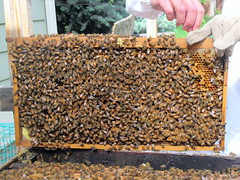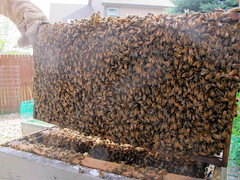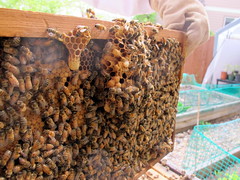During the inspection I'd done on the 19th, I had half a dozen BIG larvae out of their comb in the middle of the area between the two deep brood boxes. I was worried that I'd just killed a bunch of queen larvae, but they were all together. It turns out that if the hive is making queens, they usually spread them around the box, half a dozen of them. And the only way I could tell if they were really doing that was by doing in and looking through the whole top box, which is where most of the new eggs and larvae now are.
I had one objective on the 19th, which was to get the screened bottom board in and give the hive the ventilation it needed. On the 20th, I wanted to do a complete inspection of the top box, and get some powdered sugar into the hive for the mites. Plus, on the 19th, one of the frames in the top box had the bottom bar break free of the frame, so I needed to wire it together so that it wouldn't fall apart.
When I finally got around to getting the frame out, balance on the edge of the box, and a wire around it, I found that I couldn't manipulate the wire except by taking a glove off. It was just too thin a wire, and there were too many manipulations I had to do very carefully for me to be able to do it any way but barehanded.
I was shaking pretty badly with that, but none of the girls bothered my hand at all. There were four of them bumping constantly at my veil and buzzing me continuously, but none of them bothered my hand at all. I was pretty impressed. I did get the wire around the frame and twisted together to hold. I was amazed at how hard that actually turned out to be, but I think it'll be all right. The bees can't get rid of the wire the way they can bite and chew and remove rubber bands (it still amazes me how quick they are to do that).
But the old deep frame are definitely coming apart.
The entire hive was just dripping with bees. So many bees that I couldn't even see everything that the comb was holding, but this particular blanket of bees was pretty smooth. Queen cells are bumps that are on the edges, usually, and by themselves, whereas the regular worker brood is more like this, just covered with nurse bees and the foragers who are bringing in pollen and nectar to feed all the babies.
I was amazed. The upper box had been much lighter than the lower box, but then again the lower box was more full of honey. If the upper was nearly entirely full of brood, it would be lighter than the liquid content of the honey boxes and frames.
There were some lumps and bumps, and sections that the girls had built when and where the neighboring frame was bare.
It allowed them to build the drone comb, where the cells are MUCH bigger than the worker comb, and they fill them with the male drones. The drones are very large, and they grow in packs like the big lump there in the middle. One of the strange things was realizing that there were no queen cells but a whole lot of drone clumps in all the edges and nooks and crannies that I hadn't really been able to see that much of. One of the really big chunks was right where those other poor larvae had fallen out when I'd pulled apart the boxes.
So there were drones, but all good, healthy hives are going to throw off a lot of drones this time of year. It's a way of sharing the hive's genetics, and it's a natural part of the bounty of the nectar flow. The good news was that I didn't see any queen cells at all. And I was able to drop a lot more powdered sugar on everyone. *laughs*
One of the strangest "growths" was this one, which was at the bottom corner of one of the frames. The facing frame was completely bare. This was made even more strange with the powdered sugar which I put on before I took the picture, by accident. But the fall of sugar makes it even odder yet.
Still, it really look like drone comb to me, just big cells all together instead of single Queen cells. So it looks like the hive isn't going to be swarming soon, and I'm trying to stay ahead of it by adding supers and making the hive bigger all the time.




No comments:
Post a Comment